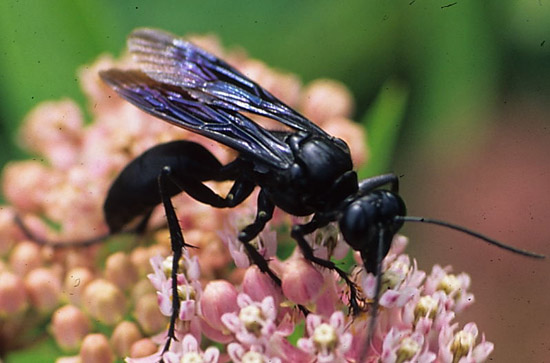Issue 14, August 22, 2011
Large Wasps
There are a number of large wasps that are present in landscapes at this time of year. They are primarily interested in feeding themselves on flower pollen and collecting insects or spiders to feed their young. As such, they are very unlikely to sting people unless grabbed or stepped on when barefoot. However, their large size makes them obvious to clientele who worry about getting stung or at least ask you what they are.
Cicada killers were discussed in Issue 12 of this newsletter published on July 25, 2011.
Scoliid wasps were also mentioned in the same issue in the green June beetle article as their larvae feed on the beetle grubs. The adult wasps have emerged and are black and red with yellow spots on the abdomen. They are about one inch long and have bluish transparent wings. They are quite active during the day flying low over the turf. Adult wasps lay eggs in the soil where green June beetle larvae are present. Once the eggs hatch, the wasp larvae tunnel through the soil searching for grubs to attack.

Scoliid wasp.
Velvet ants are covered with felt-like orange to red setae. These wasps also have dark-colored bands or other markings. They range in size from one-quarter inch for the males of some species to one inch long in other species. Velvet ants feed as larvae on the larvae of bumblebees, cicada killers, and other bees and wasps. In many species, the female is wingless and is similar in appearance to a large, fuzzy ant; she enters bee and wasp nests to lay her eggs. Velvet ants are very hard-shelled to withstand the stings of bees and wasps that discover them in their nests. Males are winged and are active fliers, but are not as aggressive towards people as male cicada killers.
Spider wasps vary in size, but the most obvious species are shiny black to blue-black and are one and one-half inches long. Some species also have red or yellow markings on them. Their wings are transparent black, bluish-black, or reddish. Their larvae feed on stung and paralyzed, but still living, spiders that the mother collects. Similar to velvet ants, spider wasps are also very hard-shelled to withstand bites from their spider prey. In the southwest U.S., there are very large species of spider wasps that attack tarantulas. In Illinois, spider wasps tend to attack wolf spiders and grass spiders.

Adult spider wasp.
(Phil Nixon)
Author:
Phil Nixon